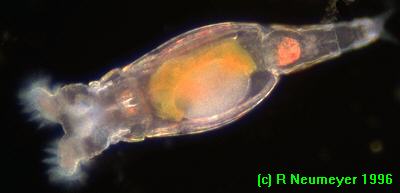

The rotifer, genus Philodina, was captured from a bird bath in early Spring. It had been gorging itself on Haematococcus pluvialis, a flagellated algae with a massive bell-shaped chloroplast usually masked by an abundance of red pigment (haematochrome). The red colouration of the gut is due to accumulated pigment from digested algal cells.
I used a Leitz 12.5X (NA 0.30) apochromatic objective, 10x Periplan eyepiece and dark field condenser. The microscope stand is a Leitz Ortholux with the trinocular, FSA head. My camera setup consists of a Canon T-90 and TL 300 flash. The camera and flash are electronically integrated, with the camera "computer" controlling flash output (duration) via two internal sensor elements. There are several sensor modes, one of which is spot-metering, used to take this picture (a very useful feature with dark field).
The flash is directed through a home-made beam splitter in order to
allow concurrent use of the normal illumination system. To take a picture
with this setup all I need to do is press an electronic release button
while viewing the subject. The camera does the rest automatically, even
advancing the film! A perfectly exposed and properly colour-balanced image
results every time. The film was Kodak Ektachrome Elite 100.
Editor's Note: The Micscape and Microscopy UK Editors thank Ron Neumeyer for submitting the superb image and informative text for this month's Image of the Month.
Comments to the author Ron Neumeyer welcomed.
Micscape is the on-line monthly magazine of the Microscopy
UK web
site at Microscopy-UK
WIDTH=1